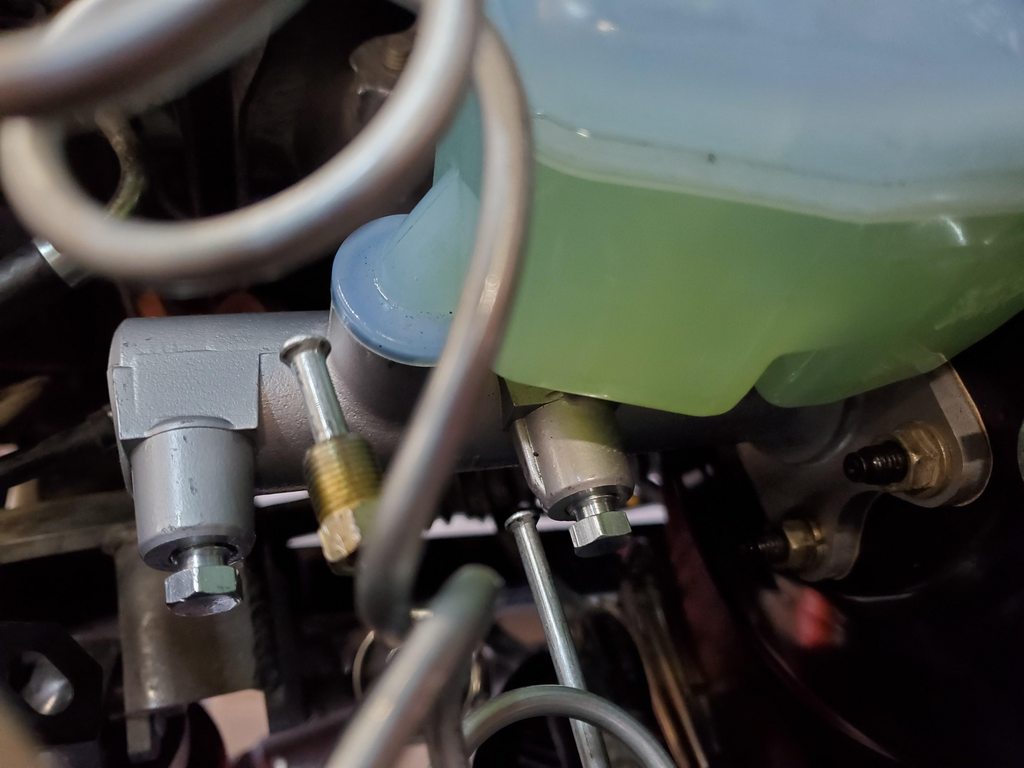UPDATE TIME!
Got everything wrapped up, bolted together and bled. First road test...AWFUL. Brakes were terrible, worse than before. Something was up. Did several rounds of the traditional 2-person bleed and still nothing. Went through almost a gallon of brake fluid, super mushy brakes.
I was convinced I had a bad MC even though it was a brand new Aisin unit. So I started diagnosing. No leaks anywhere. Wasn't losing any fluid after several road tests. To test the master cylinder, I used a pair of 10mm x 1.0 inverted flare steel plugs purchased from BelMetric. These are great to have on hand for testing or in case you need to plug a line on the trail.
BLP10X1.0DF - Metric Brake Line Plug [BLP10X1.0DF] - $3.63 : Bel-Metric, Metric Hardware, Metric Fasteners, Metric Bolts, Metric Nuts & Time-Sert Thread Repair - https://www.belmetric.com/double-flare-c-17_564_1107_1109/blp10x10df-metric-brake-line-plug-p-13727.html?zenid=1cpo4ko183dkj4vjcdss8bqd20
I plugged both ports on the MC as shown below. Started the truck, pressed on the brake pedal. It wouldn't budget, rock solid. This told me the MC was fine. If the MC was bad, I would expect the pedal to move a bit as fluid blew past the seals and circulated back into the reservoir.
Next step, I left the front capped off and connected the rear line only then proceeded to bleed. After a few bleeds I got a NASTY stream of bubbles with the flaky residue that came out. Who knows where this rogue air pocket was and it's strange that no matter what I did, I could not purge it out doing a standard bleed with all circuits connected, even after going through almost a gallon of fluid.
Started the truck with only the rear line connected, brake pedal felt great! Super firm. Rolled it a few feet in the driveway, great pedal feel. But brakes obviously sucked because it was just the rear.
Then connected the front + rear. MUSHY. Bled again, still mushy. Disconnected the rear and did the front only. Bled bled bled, few tiny bubbles, nothing major. Started the truck, pedal was firm. Okay that's good right? Rolled it a few feet, pedal still firm.
Connected the rear again (all ports connected), bled bled bled. Mushy again. Ready to light the truck on fire. If I ask the wife to help me bleed again I'm afraid she's taking the kid and moving out.
What now? The rear and front brakes feel great when connected individually, but when I connect front and rear it gets soft. Then it occurred to me. PUSHROD! I adjusted the pushrod on the new booster, or so I thought. Apparently wasn't enough I guess? That explains why I was getting a soft pedal with both front and rear connected; the plunger in the MC wasn't being pushed in far enough to generate enough pressure, but it worked fine for one circuit. After adjusting the pushrod out a few turns, SUCCESS!
It was a nightmare but in the end it was a rogue air pocket and poorly adjusted pushrod that was giving me grief on the new setup.
I'm not happy to report the brakes are working great. Here's a video doing 2 emergency stops from 45-50mph GPS speed. Proportioning valve is fully open. I haven't driven a stock 80 to compare or not sure how this compares with other people's rigs, but it's the best braking I've had out of this truck for a long long time. Truck is about 6500~6700lbs on chunky 37" Nitto Mud Grapplers





